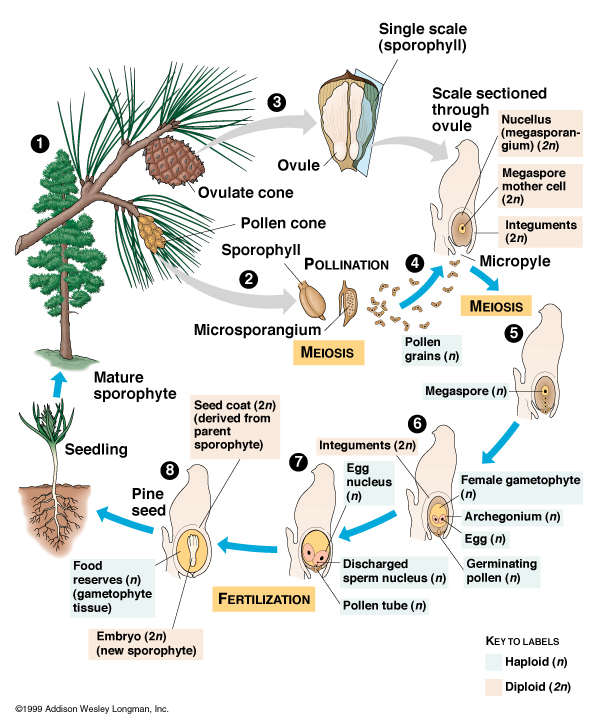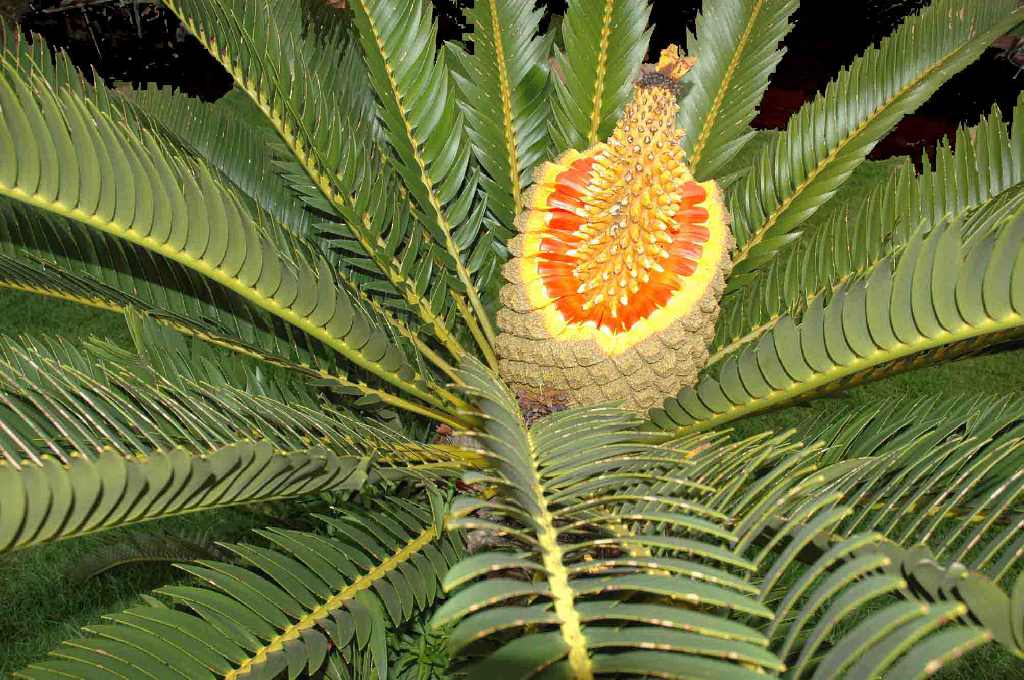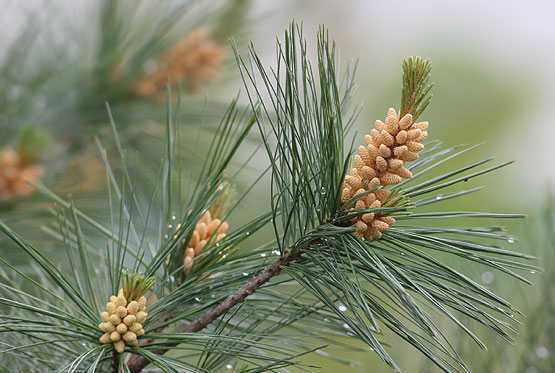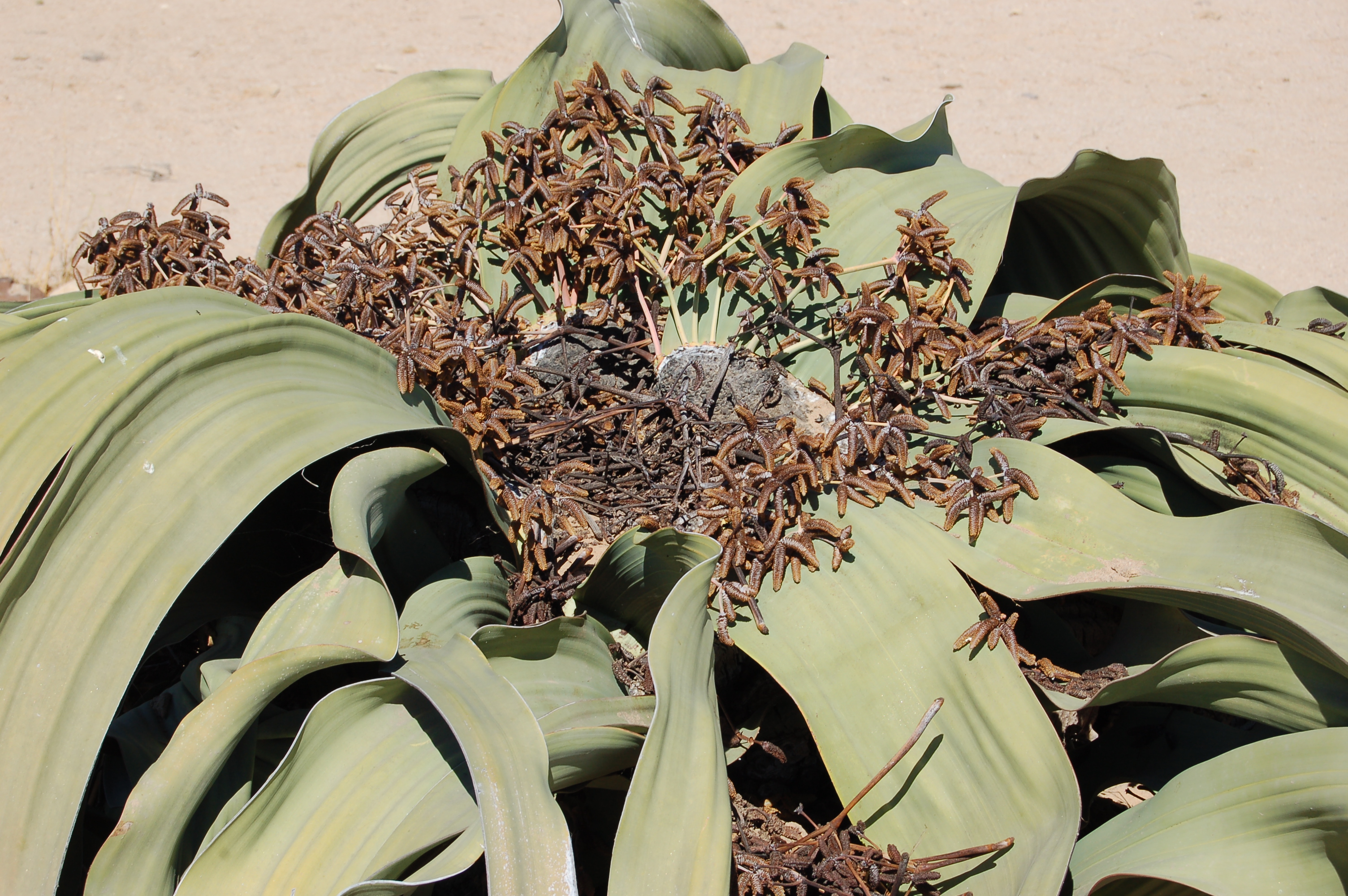


"Gymnosperms" include all seed plants other than the angiosperms, or flowering plants. The absence of an enclosing structure is believed to be primitive, thus the first seed plants were "gymnosperms." The seeds of "gymnosperms" are borne exposed in open structures, such as cones or leaves. The derivation of the word "gymnosperm" means naked seeds and is from the Greek words gymno me.aning naked or bare and sperm meaning seed. Fossil records indicate "gymnosperms" originated in the Paleozoic Era, during the middle Devonian Period about 390 million years ago, and reached their greatest diversity during the Mesozoic Era, between 60 to 225 million years ago. Although the "gymnosperms" were at one time treated as one closely allied group, many modern workers recognize several major groups, which include the commonly known conifers, cycads, and ginkgos, and the lesser known gnetopsids group, extinct progymnosperms, and extinct seed ferns.
The life cycle of "gymnosperms" depicts a dominant sporophyte and reduced gametophytes with the female gametophyte retained on the sporophyte (see illustration of conifer life cycle). The male and female sex organs may be formed in compact structures on short stem axes called cones or strobili or on specialized leaves or in flowers. In "gymnosperms", the sexes are separate, so both male and female sporangia are produced either on the same plant (monoecism) or on separate plants (dioecism). Meiosis occurs both in the pollen (male) and in the ovulate (female) cones or strobili or sporangia on specialized leaves that are formed on the sporophyte.
The pollen strobili have many sporangia (microsporangia) in which pollen mother cells (microspore mother cells) undergo meiosis to produce pollen grains (male gametophytes). The mature pollen grain (1n) is winged in many "gymnosperms", a feature that facilitates air transport. Most "gymnosperms" are wind-pollinated except for cycads, which are beetle-pollinated.
In the ovulate cones, there are one or more ovules located at the base of each cone scale (=short shoot). An ovule consists of a megasporangium, is surrounded by a single covering or integument, and eventually will become a seed. In each ovule, a megaspore mother cell undergoes meiosis to produce four megaspores, of which three disintegrate and one forms the female gametophyte (1n). The female gametophyte contains two or three groups of cells called archegonia, each of which contains a large egg nucleus.
"Gymnosperms" are a diverse and paraphyletic group of seed plants, and can be characterized by the following features: exposed seeds formed in cones, pollination occurring by pollen landing directly on the ovules, generally one fertilization event in the ovules, and tracheids as the water-conducting cells (xylem) in the vascular system. The groups of living gymnosperms are the conifers, cycads, Ginkgo, and Gnetales. These can be identified by observing habit, leaf type, and position and structure of the reproductive organs.

This group includes a single living species, Ginkgo biloba or maidenhair tree, in the family Ginkgoaceae. Leaves of Ginkgo are well-represented in the fossil record and confirm that the plants were abundant 170 million years ago during the mid-Jurassic Period of the Mesozoic Era. The leaves are deciduous, alternate, and fan-shaped, and show dichotomously branched veins. The plants are dioecious with pairs of unprotected ovules formed at the ends of short shoots and with pollen produced in male sporangia aggregated to form a cone-like organ.

The cycads are distinctive palm-like plants that grow in tropical and subtropical regions of the world. They form thick, slow-growing stems, and large compound leaves that are either erect and conduplicate, or involute with the main axis emerging erect from the apical bud and with each leaflet coiled inward, or expanding from a circinate position. The leaves form crowns at the end of the stem apices. Cycads are dioecious and produce cones or sporangia borne on open sporophylls.

Conifer is a Latin word, a compound word of conus and ferre (to bear), meaning the one that bears (a) cone(s). The conifers, division Pinophyta, also known as division Coniferophyta or Coniferae, are one of 13 or 14 division level taxa within the Kingdom Plantae. Pinophytes are gymnosperms. They are cone-bearing seed plants with vascular tissue; all extant conifers are woody plants, the great majority being trees with just a few being shrubs. Typical examples of conifers include cedars, Douglas-firs, cypresses, firs, junipers, kauri, larches, pines, hemlocks, redwoods, spruces, and yews.

The gnetopsids contain three highly distinctive monotypic families (each with one genus): Gnetaceae (Gnetum), Ephedraceae (Ephedra), and Welwitschiaceae (Welwitschia). The gnetopsids are non-angiospermous seed plants. Some recent studies suggest that, among extant or living plants, the gnetopsids are the closest relatives of angiosperms or flowering plants. The vessels in the wood of gnetopsids are derived from tracheids with circular bordered bits, in contrast to the vessels of angiosperms, which are derived from scalariform tracheids.